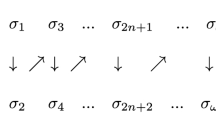Abstract
Tarski avoids the liar paradox by relativizing truth and falsehood to particular languages and forbidding the predication to sentences in a language of truth or falsehood by any sentences belonging to the same language. The Tarski truth-schemata stratify an object-language and indefinitely ascending hierarchy of meta-languages in which the truth or falsehood of sentences in a language can only be asserted or denied in a higher-order meta-language. However, Tarski’s statement of the truth-schemata themselves involve general truth functions, and in particular the biconditional, defined in terms of truth conditions involving truth values standardly displayed in a truth table. Consistently with his semantic program, all such truth values should also be relativized to particular languages for Tarski. The objection thus points toward the more interesting problem of Tarski’s concept of the exact status of truth predications in a general logic of sentential connectives. Tarski’s three-part solution to the circularity objection which he anticipates is discussed and refuted in detail.
Similar content being viewed by others
References
Davidson D. (1984) Inquiries into truth and interpretation. The Clarendon Press, Oxford
Field H. (1972) Tarski’s theory of truth. The Journal of Philosophy 69: 347–375
Gupta A. (1993) A critique of deflationism. Philosophical Topics 21: 57–81
Halbach V. (1999) Disquotationalism and infinite conjunctions. Mind 108: 1–22
Hintikka J. (1975) A counterexample to Tarski-type truth-definition as applied to natural languages. Philosophia 5: 207–212
Ketland J. (1999) Deflationism and Tarski’s paradise. Mind 108: 69–94
Tarski, A. (1923). On the primitive term of logistic. Logic, Semantics, Metamathematics, pp 1–23.
Tarski, A (1935a). Foundations of the calculus of systems. Logic, Semantics, Metamathematics, pp. 342–383.
Tarski, A. (1935b). On extensions of incomplete systems of the sentential calculus. Logic, Semantics, Metamathematics, pp. 393–400.
Tarski, A. (1937). Sentential calculus and topology. Logic, Semantics, Metamathematics, pp. 421–454.
Tarski A. (1944) The semantic conception of truth and the foundations of semantics. Philosophy and Phenomenological Research 4: 341–375
Tarski, A. (1983). The concept of truth in formalized languages. In Tarski A (Ed.), Logic, semantics, metamathematics: Papers from 1923 to 1938 (J. H. Woodger, trans), 2nd edn, edited by J. Corcoran, (pp. 152–278). Indianapolis: Hackett Publishing Company.
Author information
Authors and Affiliations
Corresponding author
Rights and permissions
About this article
Cite this article
Jacquette, D. Circularity or Lacunae in Tarski’s Truth-Schemata. J of Log Lang and Inf 19, 315–326 (2010). https://doi.org/10.1007/s10849-009-9103-z
Published:
Issue Date:
DOI: https://doi.org/10.1007/s10849-009-9103-z




